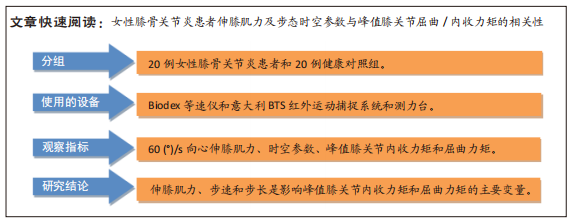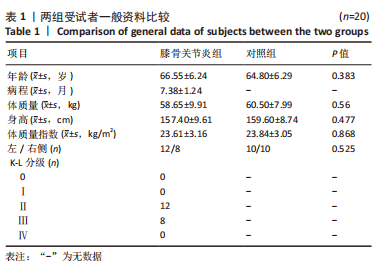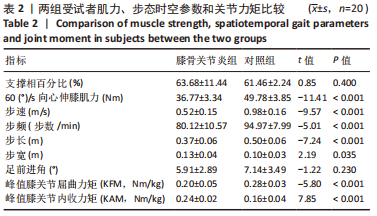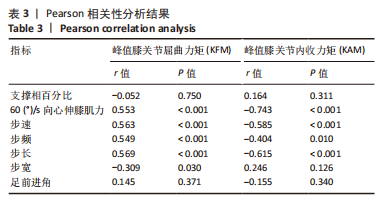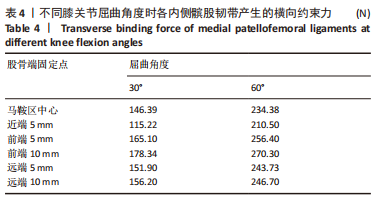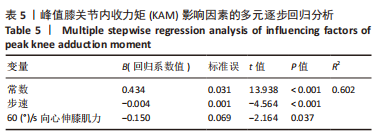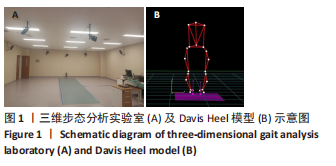[1] ALENAZI AM, ALQAHTANI BA, VENNU V, et al. Gait Speed as a Predictor for Diabetes Incidence in People with or at Risk of Knee Osteoarthritis: A Longitudinal Analysis from the Osteoarthritis Initiative. Int J Environ Res Public Health. 2021; 18(9):4414.
[2] BANNURU RR, OSANI MC, VAYSBROT EE, et al. OARSI guidelines for the non-surgical management of knee, hip, and polyarticular osteoarthritis. Osteoarthritis Cartilage. 2019;27(11):1578-1589.
[3] METCALFE AJ, ANDERSSON ML, GOODFELLOW R, et al. Is knee osteoarthritis a symmetrical disease? Analysis of a 12 year prospective cohort study. BMC Musculoskelet Disord. 2012;13:153.
[4] JONES RK, CHAPMAN GJ, FINDLOW AH, et al. A new approach to prevention of knee osteoarthritis: reducing medial load in the contralateral knee. J Rheumatol. 2013;40(3):309-315.
[5] DE ROOIJ M, VAN DER LEEDEN M, HEYMANS MW, et al. Prognosis of Pain and Physical Functioning in Patients With Knee Osteoarthritis: A Systematic Review and Meta-Analysis. Arthritis Care Res (Hoboken). 2016;68(4):481-492.
[6] BINDAWAS SM, VENNU V, AL SNIH S. Differences in health-related quality of life among subjects with frequent bilateral or unilateral knee pain: data from the Osteoarthritis Initiative study. J Orthop Sports Phys Ther. 2015;45(2):128-136.
[7] CROSS M, SMITH E, HOY D, et al. The global burden of hip and knee osteoarthritis: estimates from the global burden of disease 2010 study. Ann Rheum Dis. 2014; 73(7):1323-1330.
[8] 冯晓晴, 蔡道章, 余星磊,等. 基于GBD大数据中国膝骨关节炎疾病负担现状与趋势分析[J]. 现代预防医学,2022,49(10):1753-1760.
[9] BLACK AL, CLARK AL. Sexual dimorphism in knee osteoarthritis: Biomechanical variances and biological influences. J Orthop. 2022;32:104-108.
[10] EBERT JR, HAMBLY K, JOSS B, et al. Does an unloader brace reduce knee loading in normally aligned knees?. Clin Orthop Relat Res. 2014;472(3):915-922.
[11] 张晶晶, 安丙辰, 郑洁皎. 足前进角改善膝骨关节炎症状及其机制的研究进展[J].中国康复理论与实践,2015,21(7):790-792.
[12] BALIUNAS AJ, HURWITZ DE, RYALS AB, et al. Increased knee joint loads during walking are present in subjects with knee osteoarthritis. Osteoarthritis Cartilage. 2002;10(7):573-579.
[13] THORP LE, SUMNER DR, WIMMER MA, et al. Relationship between pain and medial knee joint loading in mild radiographic knee osteoarthritis. Arthritis Rheum. 2007;57(7):1254-1260.
[14] MIYAZAKI T, WADA M, KAWAHARA H, et al. Dynamic load at baseline can predict radiographic disease progression in medial compartment knee osteoarthritis. Ann Rheum Dis. 2002;61(7):617-622.
[15] CHEHAB EF, FAVRE J, ERHART-HLEDIK JC, et al. Baseline knee adduction and flexion moments during walking are both associated with 5 year cartilage changes in patients with medial knee osteoarthritis. Osteoarthritis Cartilage. 2014;22(11): 1833-1839.
[16] WALTER JP, D’LIMA DD, COLWELL CW Jr, et al. Decreased knee adduction moment does not guarantee decreased medial contact force during gait. J Orthop Res. 2010;28(10):1348-1354.
[17] BARRIOS JA, HIGGINSON JS, ROYER TD, et al. Static and dynamic correlates of the knee adduction moment in healthy knees ranging from normal to varus-aligned. Clin Biomech (Bristol, Avon). 2009;24(10):850-854.
[18] ALLET L, IJZERMAN H, MEIJER K, et al. The influence of stride-length on plantar foot-pressures and joint moments. Gait Posture. 2011;34(3):300-306.
[19] FAVRE J, ERHART-HLEDIK JC, CHEHAB EF, et al. General scheme to reduce the knee adduction moment by modifying a combination of gait variables. J Orthop Res. 2016;34(9):1547-1556.
[20] 乐意, 金荣疆, 阳杨,等.从下肢生物力学来解析膝骨关节炎[J].中国康复理论与实践,2013,19(6):505-509.
[21] PIETROSIMONE B, DAVIS-WILSON HC, SEELEY MK, et al. Gait Biomechanics in Individuals Meeting Sufficient Quadriceps Strength Cutoffs Following Anterior Cruciate Ligament Reconstruction. J Athl Train. 2021;56(9):960-966.
[22] 中华医学会骨科学分会关节外科学组, 中国医师协会骨科医师分会骨关节炎学组, 国家老年疾病临床医学研究中心(湘雅医院),等. 中国骨关节炎诊疗指南(2021年版)[J].中华骨科杂志,2021,41(18):1291-1314.
[23] SPINOSO DH, BELLEI NC, MARQUES NR, et al. Quadriceps muscle weakness influences the gait pattern in women with knee osteoarthritis. Adv Rheumatol. 2018;58(1):26.
[24] SCHWARTZ M H, ROZUMALSKI A. The Gait Deviation Index: a new comprehensive index of gait pathology. Gait Posture. 2008;28(3):351-357.
[25] JOCHYMCZYK-WOźNIAK K, NOWAKOWSKA K, POLECHOńSKI J, et al. Physiological Gait versus Gait in VR on Multidirectional Treadmill-Comparative Analysis.Medicina (Kaunas). 2019;55(9):517.
[26] 毕耕超, 张彦龙, 李秋月,等.不同高度和间距下跳深动作中膝关节力学和周围肌肉的激活特征[J]. 中国组织工程研究,2023,27(8):1211-1218.
[27] 黄萍,王怡,陈博,等. 膝骨关节炎患者的三维运动解析[J].中国全科医学, 2020,23(17):2169-2176.
[28] FREGLY BJ, REINBOLT JA, ROONEY KL, et al. Design of patient-specific gait modifications for knee osteoarthritis rehabilitation. IEEE Trans Biomed Eng. 2007; 54(9):1687-1695.
[29] FOROUGHI N, SMITH R, VANWANSEELE B. The association of external knee adduction moment with biomechanical variables in osteoarthritis: a systematic review. Knee. 2009;16(5):303-309.
[30] 张旻, 江澜. 内侧间室膝骨性关节的下肢关节生物力学变化[J]. 中国康复, 2011,26(1):36-38.
[31] PALMIERI-SMITH RM, THOMAS AC. A neuromuscular mechanism of posttraumatic osteoarthritis associated with ACL injury. Exerc Sport Sci Rev. 2009;37(3):147-153.
[32] HUANG C, CHAN P K, CHIU K Y, et al. Exploring the relationship between pain intensity and knee moments in participants with medial knee osteoarthritis: a cross-sectional study. BMC Musculoskelet Disord. 2021;22(1):685.
[33] CREABY MW, HUNT MA, HINMAN RS, et al. Sagittal plane joint loading is related to knee flexion in osteoarthritic gait. Clin Biomech (Bristol, Avon).2013;28(8): 916-920.
[34] TELFER S, LANGE MJ, SUDDUTH A. Factors influencing knee adduction moment measurement: A systematic review and meta-regression analysis. Gait Posture. 2017;58:333-339.
[35] GUPTA D, DONNELLY CJ, REINBOLT JA. Finding Emergent Gait Patterns May Reduce Progression of Knee Osteoarthritis in a Clinically Relevant Time Frame.Life (Basel). 2022;12(7):1050.
[36] FREGLY BJ, REINBOLT JA, CHMIELEWSKI TL. Evaluation of a patient-specific cost function to predict the influence of foot path on the knee adduction torque during gait. Comput Methods Biomech Biomed Engin. 2008;11(1):63-71.
[37] SCHWAMEDER H, LINDENHOFER E, MüLLER E. Effect of walking speed on lower extremity joint loading in graded ramp walking. Sports Biomech. 2005;4(2):227-243.
[38] DE DAVID AC, CARPES FP, STEFANYSHYN D. Effects of changing speed on knee and ankle joint load during walking and running. J Sports Sci.2015;33(4):391-397.
[39] LAM WK, LEE KK, PARK SK, et al. Understanding the impact loading characteristics of a badminton lunge among badminton players. PLoS One. 2018;13(10):e0205800.
[40] HALL M, WRIGLEY TV, METCALF BR, et al. Mechanisms underpinning the peak knee flexion moment increase over 2-years following arthroscopic partial meniscectomy. Clin Biomech (Bristol, Avon). 2015;30(10):1060-1065.
[41] PALMIERI-SMITH RM, KREINBRINK J, ASHTON-MILLER JA, et al. Quadriceps inhibition induced by an experimental knee joint effusion affects knee joint mechanics during a single-legged drop landing. Am J Sports Med. 2007;35(8):1269-1275.
|
